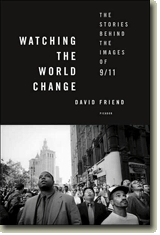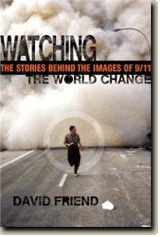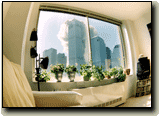« Previous · Home · Next »
September 19, 2006
COURSES, CRITICS, COMMENTS
Two professors have written to say they will teach Watching the World Change in their classes – one this fall, at Columbia; another in the spring, at Amherst.
The reviews continue to be kind. The San Francisco Chronicle calls the book “powerful, riveting, often emotional, [a] tour d’horizon… Its author never los[es] sight of the human lives lost. It is a tribute to Friend’s sense of proportion – and to his essential humanity.” The Chicago Tribune considers it “riveting…wide-ranging and stimulating [by] a skilled and lively writer.” The Hartford Courant asserts that it “covers the visual record of post 9/11 America with the same attention to detail and hard analysis that David Halberstam devotes to political events. The result is an engaging account that makes readers feel that no image is really complete until we understand the history behind it.” The Christian Science Monitor summarizes the book “a fascinating day by day account…with perceptive commentary.” Atlanta Life says: “At times, his eloquent prose reads like poetry that begs to be reread….Friend’s book forces us to remember what we want to forget.”
And the comments pour forth via e-mail…
Connie Maschera, from Woodstock, Georgia:
I first fell in love with New York City in 1969 (my first visit) and it has been a love affair that has lasted a lifetime. My oldest son went to graduate school there and I visited often. One of my favorite things to do in NYC, was ride the Staten Island ferry. I loved that view of the towering buildings of lower Manhattan.
In March of 2003, I was in the city, visiting a friend. I rode the subway alone down to ground zero and then took my customary ride on the ferry. It was my first trip to NYC after 9/11. As the ferry pulled away, I had tears rolling down my face at my first sight of the receding skyline that was once my favorite view of the city. A man standing next to me, put his hand on my shoulder and said, "I ride this ferry every day and it is a sight that you never get used to." We chatted for a while and parted on the other side and I rode back.
It was a sad day spent walking the streets of lower Manhattan, reflecting on all the lives lost, and the scar that remains in this city that I love. The buses full of tourists seemed almost a sacrilege.
We may have moved on, but we certainly have not forgotten.
Michele Slung, from Woodstock, New York, writes to say she has been put off by online columnists debating Thomas Hoepker and William Lamson photos below (in the September 10 and 13 entries):
It was one of the most beautiful mornings ever woken up to, and how do people not in the shadow, not running for their lives (possibly not even aware of the total vast enormity of the event at that moment) look suitably distressed? Jaws agape, grimacing, clutching their heads, writhing on the ground? Who knows what they were saying or thinking? Am I missing something here? The sky was indeed that glorious blue everywhere in the region, as I don't have to tell you: that was the way the world looked beyond the smoke and falling ash of Tribeca.
These pictures for me embody the insanely hard-to-take-in contrast of the morning --- the hijackers could just as easily have had something like the rainy gloom of so many recent days. But the day they got turned out to be perfect for heightening the disjunction and disbelief, and Lamson has a point about simply not knowing what was to come, imagining it would be "fixed," that a relaxed-seeming spectator's attitude really just indicates no pre-vision. At that moment, the horror was contained and the banality of everyday life maintained; soon, though, the horror was everywhere. Yet people have gone on living their lives and can't help being out in the sunshine, so to speak.
What these images are are "elephants" for columnists, commentators and bloggers, who see what their predispositions or agendas would have them see. To me, they are simply pictures dramatically showing the truth of the morning.


